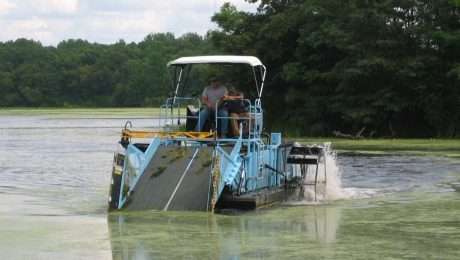Stay up to date with the latest news, insights, and updates from Aquarius Systems. Our blog covers waterway management, aquatic plant control, environmental challenges, equipment innovations, and stories from around the world that impact our lakes, rivers, and communities.
As the harvest season winds down, aquatic weed harvesters across the region are being pulled from the water and stored for winter. For many lake districts, this time of year brings a chance to reflect on the season’s results—and the numbers out of Polk County are impressive. The Apple River Protection and Rehabilitation District (ARPRD)
Lakes across the country are struggling with harmful algal blooms, low oxygen, and declining fish populations. While these problems are often obvious at the surface, many management practices are based on misconceptions that don’t address the real causes. Instead of solving the issue, they often make lakes even sicker. Chemical Treatments: A
In 2023, invasive quagga mussels were discovered in the Snake River near Twin Falls, Idaho. To stop the spread, officials carried out a large-scale chemical treatment using copper-based products. Two years later, the results show just how much damage these treatments can cause—and how little success they’ve had in eliminating the mussels. Chemical Treatments: Lethal
A closer look at how Eurasian milfoil and chemical treatments are harming aquatic life Flint Lake on Valparaiso’s north side is in trouble. Invasive aquatic weeds, especially Eurasian milfoil, have become so overgrown that they’re even interfering with fish population surveys. During a recent Department of Natural Resources (DNR) survey, biologists had to stop two
Lake Victoria, the second largest freshwater lake in the world, is an essential resource for the people of Kenya, Tanzania, and Uganda. It provides food, clean water, hydroelectric power, and transportation. However, the lake faces a major challenge due to the spread of water hyacinth, an invasive plant that grows quickly and forms thick mats
Wake boats, designed to create large waves for activities like wakeboarding and wakesurfing, have become a contentious issue on Wisconsin lakes. While these boats provide fun and excitement for water sports enthusiasts, they also raise concerns among other lake users and environmental advocates. The main issues with wake boats include: Shoreline Erosion: The large wakes
As the seasons shift and temperatures drop, lake and pond owners must turn their attention to managing aquatic weeds that have accumulated over the warmer months. Fall offers a prime opportunity for aquatic weed harvesting, not only to maintain the health of the waterbody through the colder months but also to prepare it for the
The year 2024 marks the 50th anniversary of Wisconsin’s unique lake law, Chapter 33: Public Inland Waters. The legislature and governor worked together in the early 1970s to establish a collaborative research and management framework that lives on today as the Wisconsin Lakes and Rivers Partnership. The law also created a pathway for landowners around
Amphibians are highly sensitive to changes in their environment, especially when it comes to water quality. As such, they can serve as excellent indicators of the health of aquatic ecosystems, providing valuable insights into the state of the environment and potential problems that may be affecting the water quality. Amphibians are unique creatures that have
Created by melting glaciers thousands of years ago, Lake George is 43,471 acres, 32 mile long, up to 2.5 mile wide and up to 200 feet deep. Located at the southern end of the Adirondack Park in Upstate New York, Lake George is the primary driver of regional tourism, generating $2 billion in annual economic










